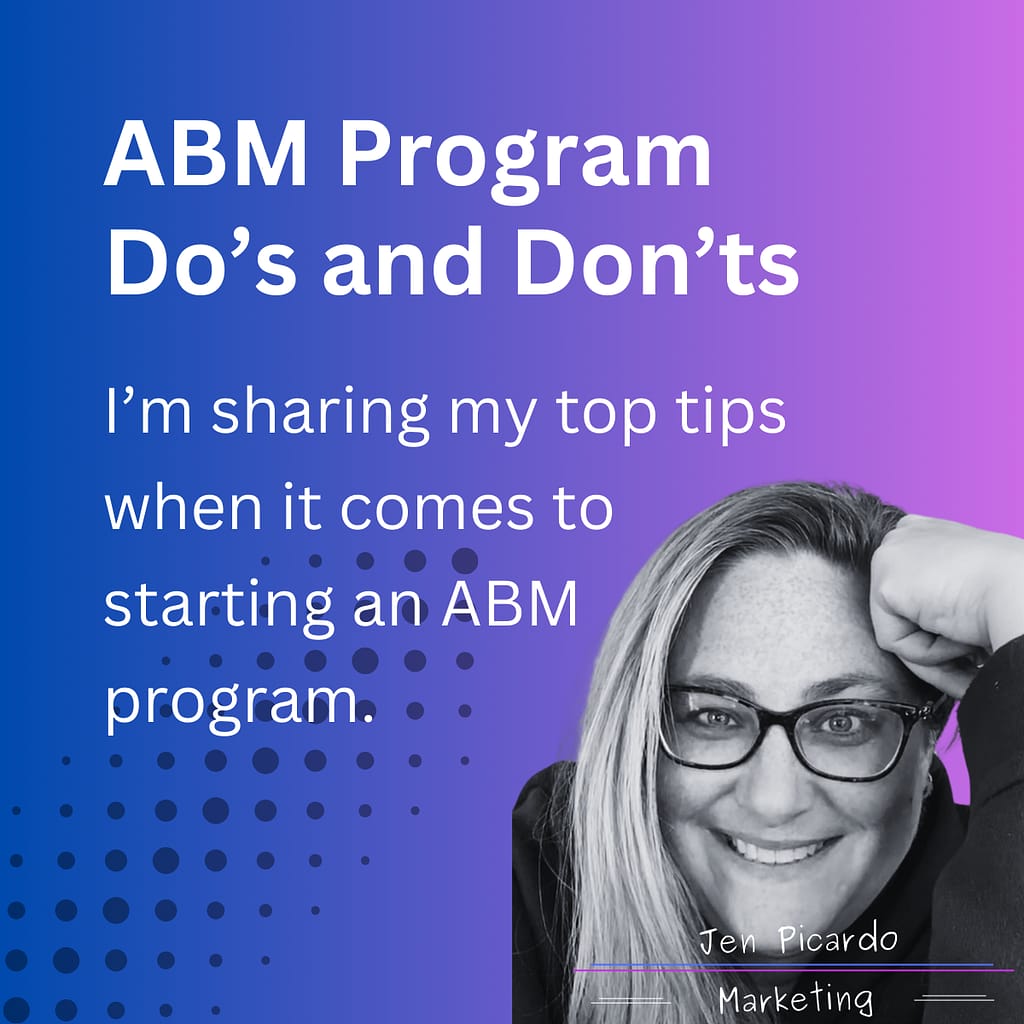The Do’s and Don’ts of ABM Programs
ABM programs are not all built the same. It’s critical to view ABM as a framework and not a campaign. If you haven’t operationalized your ABM Program yet, I encourage you to do so.
In this blog I’m sharing my top tips to get you started on your ABM journey. These do’s and don’ts are best practices and can serve as guardrails for your ABM program.
Let’s dive in!

- Identify your target accounts – Your target accounts should be high-value accounts where there is opportunity for growth. That doesn’t mean the account will have high value in your first deal. It means it’s an account you can “land and expand”.
Don’t prioritize quantity over quality – ABM programs engage fewer, high-value accounts.
- Score your target accounts – All target accounts are not created equal. Develop criteria for your ICP and score each account against it. The highest scoring accounts should be top priority.
Don’t rely on your guy instincts about an account – Do your research and make sure the account lines up with your overall strategy and goals.
- Leverage existing relationships – Lean in to where connections already exist for nurturing, fact-finding, and introductions.
Don’t rely solely on cold outreach – Warm up accounts through content, ads, and social engagement first.
- Align sales & marketing – Ensure both teams are on the same page about target accounts, messaging, goals, and most importantly, responsibilities and expectations.
Don’t underestimate the power of social selling – Engaging with prospects on LinkedIn can significantly impact relationships.
- Multi-channel engagement is key – Your marketing mix should include email, LinkedIn, direct mail, events, and paid ads. And messaging should be aligned across all channels.
Don’t rely on a single channel – Remember, you are targeting the entire account. How and where you digest content may be different than decision makers. Different generations consume on different platforms.
- Personalize everything – Tailor content, emails, ads, and even landing pages to the specific needs of each target account. This is particularly important for those accounts in 1-to-1 ABM programs.
Don’t use a one-size fits all approach – Generic messaging won’t resonate with high-value accounts.
- Create valuable content – Understanding your customers pain points helps you create better content, like case studies, whitepapers, and industry insights, that provide solutions to things your customers care about. Use multiple forms of content, including video.
Don’t forget to showcase your expertise – Surface-level knowledge, especially in the middle and bottom of the funnel, won’t create meaningful connections with decision-makers.
- Use data & insights – Evaluate your ICP, intent data, and behavioral analytics to identify and engage high-value accounts and inform next steps.
Don’t rely on assumptions – Follow what the intent topics, keyword searches, pages viewed, and overall engagement levels are telling you.
- Measure & optimize – Track KPIs like engagement, pipeline velocity, deal size, and win rates.
Don’t ignore attribution models – Attribution models can help you understand what’s working and the influence on revenue. - Leverage technology – CRM, ABM platforms and marketing automation platforms should be fully integrated for seamless data sharing and execution.
Don’t operate in silos – This creates inefficiencies and misalignment between marketing and sales. - Focus on relationship-building – Prioritize meaningful connections over quick wins.
Don’t rule anyone out – Target multiple stakeholders within an account, not just one contact.
- Be patient & persistent – ABM is a long-term strategy that requires nurturing over time.
Don’t expect immediate results – transactional deals are a rarity
- Test & iterate – Continuously optimize messaging, channels, and tactics based on performance.
Don’t treat ABM as just another campaign – ABM is a strategic approach, not a short-term marketing tactic.
Getting started may seem overwhelming, but it doesn’t have to be. Contact me today and let’s sit down and talk it out.

0 Comments